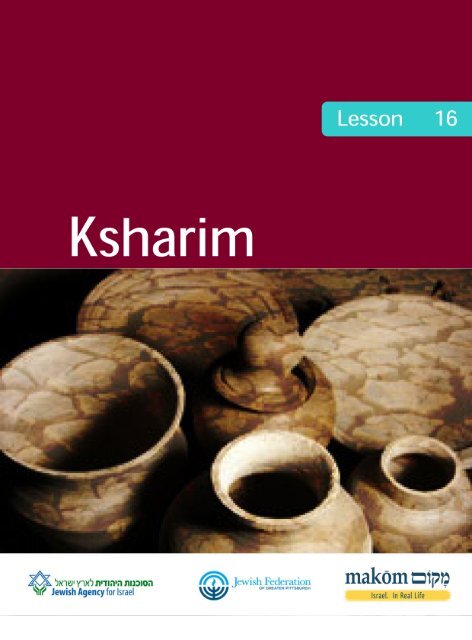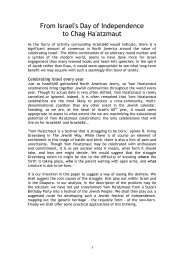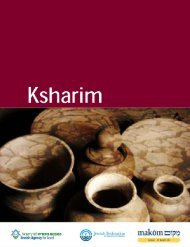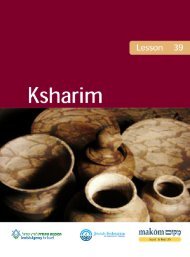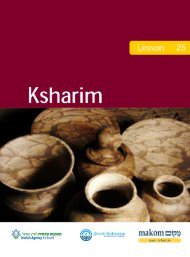Click here for printable pdf - Makom Israel
Click here for printable pdf - Makom Israel
Click here for printable pdf - Makom Israel
- No tags were found...
You also want an ePaper? Increase the reach of your titles
YUMPU automatically turns print PDFs into web optimized ePapers that Google loves.
L e s s o n 16:The Messiah[See methodological suggestions at end of lesson plan…]1. Outlinea. Prophetic originsb. Apocalyptic literaturec. Early messianic movementsd. Rabbinic viewse. As a factor in history2. IntroductionAfter all the promises and all the tests, and the centralization of our connection toGod in the Temple, the destruction of the Temple and of our sovereigntyconstituted a major spiritual crisis. It seems likely that many people saw thisdisaster as evidence that God was a failure, or non-existent. The prophets’challenge was now not just to get the people to obey the laws, but to get them notto give up on the whole project. At first, the assumption was that this disaster wasindeed a punishment, but that it would pass: we had paid the price of our sins, sonow God could <strong>for</strong>give us and get over His anger, and restore an anointed king ofDavid’s line (anointed one = mashiach = messiah), and the Temple service. As timewent on, however, this neat picture never materialized, and we had to find a wayto cope with painfully and indefinitely postponed redemption. And so, as themessiah receded into the future, he loomed larger and larger in terms of hisexpected role in the world. At the same time, we learned to live (mostly) with a“permanent” tension between present reality and our imagined utopianrestoration to the good old days (that were not as good as we imagined them).This lesson traces the development of the messianic concept, and looks ahead atits impact on later Jewish history. Our relationship to the land of <strong>Israel</strong> – and thestate of <strong>Israel</strong> – is intimately tied up with this powerful and interesting concept.3. Lesson goalsa. Awareness of the historical development of the concept of messiahb. Awareness of the connection between the messiah and our relation to EretzYisraelc. Understanding of the centrality of the messianic idea in Jewish lifed. Awareness of the impact of the messianic idea in Jewish history139 Ksharim
4. Expanded outlinea. Prophetic originsi. Anointing as the method of sanctifying a king: I Samuel 10:1. Theword mashiach, messiah, simply refers to one who has beenanointed; and in the context of biblical history, t<strong>here</strong><strong>for</strong>e, it refers tothe kingii. In II Samuel 7:11-16, God promises David that his selection as king isguaranteed <strong>for</strong> all time; the dynasty is eternal. Even though t<strong>here</strong> willbe vicissitudes, sin and punishment, the Davidic dynasty will never bedisplaced as Saul’s was. Thus, from now on, the mashiach, theanointed king, will always be a descendant of David. The problembecame, how to reconcile that promise with the events in the lastchapter of II Kings, when King Jehoiachin is exiled to Babylonia in 597BCE, and lives out his days t<strong>here</strong> as a prisoner, and 586 his successor,his uncle Zedekiah, is blinded and carried to Babylonia in chains.iii. The response of the prophets was to reaffirm the promise: theyinsisted that this eclipse would pass, and that the dynasty – and oursovereignty – and our special relation to God – would be restored; wemust not lose faith. See: Jeremiah 23:1-8, also Jeremiah 32-33; andEzekiel 37. Note that along with the restoration of David’s dynasty,the scattered people will be gat<strong>here</strong>d and restored to their land –w<strong>here</strong> they will, of course, keep the mitzvot (e.g., Ezekiel 37:23).b. Apocalyptic literaturei. Even after the defeat of Babylonia by the Persians in 537 BCE and ourencounter with a regime that did not prevent our reestablishing ourcult and some degree autonomy, the hoped-<strong>for</strong> restoration did notoccur. Simply repenting and waiting <strong>for</strong> redemption was getting tobe a frustrating and apparently long-term exercise. Perhapsinfluenced by pagan concepts of history as cyclical, a new“explanation” of our situation began to appear, in works ofapocalyptic literature. The only example in the bible is the Book ofDaniel.ii. The writers of apocalyptic literature believed that they could see theflow of history “from outside,” so that they could discern the overallstructure — and they believed that history indeed has a structure,with a beginning, a middle, and an end. In Daniel 9:20-27, Danielmeets the angel Gabriel, who reveals to him the chronology of theperiod from the beginning of the restoration of the Temple until thefinal redemption.If history has an end, and is not just an infinite series of events, thenevery passing day brings us that much closer to that end. And if weexperience the present as a time of suffering, and envision the end asa time of redemption, then we certainly would like to know how140 Ksharim
Jesus became a popular preacher in the first quarter of the firstcentury C.E.; a movement grew up based on his identification as themessiah. Since, <strong>for</strong> obvious reasons, the Romans were not interestedin encouraging Jewish claims of national sovereignty, they executedJesus. Among his followers the belief spread that he was resurrectedand taken up to heaven three days after his death, t<strong>here</strong> to wait untilmankind was ready <strong>for</strong> full redemption. This revised <strong>for</strong>m of messianicbelief, which saw the messiah as not merely a king of flesh and blood,but as a manifestation of God, became the doctrine of a sect withinJudaism. As the leaders of this sect (primarily Paul of Tarsus) directedtheir message increasingly toward the non-Jews around them — andencountered receptivity — the link to mainstream Judaism grewweaker and the centrifugal <strong>for</strong>ces grew stronger, until t<strong>here</strong> was acomplete break.ii.Bar Kochba:It seems that the expectation of messianic deliverance from thepower of Rome was so strong that the failure of the first revolt onlyintensified it. Within a few decades, normal Jewish life had beenrestored in most of the towns and villages, and the autonomouscommunal leadership based in Yavneh had been established. But thehumiliation of Roman taxation still rankled — and despite thedevelopment of alternative institutions, life without the Temple waslife in a continuous religious crisis.Neither the growth of Christianity nor the crushing blow of thedestruction of the Temple defused the pressure of the apocalypticexpectations that were widespread among the people. Manycontinued to wait impatiently <strong>for</strong> the moment of the end.Apparently, the emperor Hadrian ordered the rebuilding ofJerusalem as a pagan city, containing a pagan Temple. Such an actcan be seen as the “last straw” — or as support <strong>for</strong> thoseapocalypticists who argued that redemption wouldn’t come until theworld was wholly given over to evil.In any case, fighting broke out and was suppressed with greatbloodshed, and physical and economic devastation that surpassedthe result of the first revolt.d. Rabbinic viewsi. The rabbis faced a dilemma: the belief in the messiah and t<strong>here</strong>storation was central to Judaism; to debunk or discourage it wouldbe to go against the clear message of the prophets. On the otherhand, seeing the messiah in every populist preacher or adventurerhad been disastrous; how could one know when it was the real thing?142 Ksharim
ii.iii.How could we keep the expectation alive yet somehow consistentlyput off its fulfillment? The faith is clear in the liturgy (see blessings14 and 15 in the Shemonah Esreh). The ambivalence shows up indiscussions of messianic times in the Talmud (Sanhedrin 97-98)This tension did not go away. One of the most famous responses to itwas that of the Rambam, in the 12 th century, who earned greatunpopularity by insisting that the messianic hope refers only to t<strong>here</strong>storation of sovereignty and the Temple – not to apocalypticvisions of the re-creation of the world, the perfection of nature, etc.(see Mishneh Torah, Hilchot Melachim 11-12).Gershom Scholem, “The Messianic Idea in Judaism,” in the collectionof essays of the same name, Schocken, 1971.e. As a factor in historyi. After Jesus and Bar Kochba, the attempts to calculate the time of t<strong>here</strong>demption – or to <strong>for</strong>ce it – continued in every century and in everycorner of the Jewish world. Some of these were small scale localaffairs; some became mass movements. So far, apparently, none gotit right… Perhaps the most famous was Sabbetai Zevi, in the late 17 thcentury; a hint of its impact can be seen in the excerpt of the accountby Rycault; a more complete account can be found, <strong>for</strong> example inMarcus’ very useful anthology of short medieval texts The Jew in theMedieval World, Atheneum 1973. Abba Hillel Silver’s PhD thesis is anamazing little book cataloging messianic calculations and pretendersthrough the ages: A History of Messianic Speculation in <strong>Israel</strong>, PeterSmith 1978.ii. Even with the secularization of the modern period, the messianicspark in Judaism was not extinguished, and its light can be seen inthe rhetoric of modern movements <strong>for</strong> man-made redemption inwhich Jews played a major role. For example: enlightenment andsocialism, both of which can be seen as messianic movements, basedon a vision of redemption of the world (not just of the Jews): see textsfrom Geiger and the Arbeiter Freund.iii. W<strong>here</strong> does all this lead? Well, take the messianic belief in restorationof our glorious past national/religious existence, combine it withmodern humanism, and add turn-of-the century romanticnationalism, and what to you get? Zionism.5. Methodological suggestions:The lesson can be built quite simply around the chronological sequence of shorttexts that trace the development of the messianic idea: II Samuel 7:11-16 – the promise Jeremiah 23:1-8, Jeremiah 32 – hope out of the ashes143 Ksharim
Daniel 12 – apocalyptic vision Mark 13 – Christian apocalyptic vision Eicha Rabbati 2:5 – Bar Kochba Shemonah Esreh – messianic hope in mainstream religious practice Talmud Sanhedrin 97-98 - ambivalence Rambam – don’t get carried away! Later examples – e.g., Sabbateanism, enlightenment, socialismAs an introduction, participants might be asked to diagram their idea of the “flow”of Jewish history: is it an infinite straight line? A curve? A slope? Is t<strong>here</strong> an end?Are t<strong>here</strong> peaks?And/or: Do you believe in a messiah/messianic time/perfection/end/restoration?How do you understand the concept as expressed in the liturgy? In sayings like“Next year in Jerusalem” at Pesach?Note: messianism is a big and interesting topic, and we have only one lesson.T<strong>here</strong><strong>for</strong>e, we have pretty much ignored the whole issue of antinomianism: thebelief that when the messiah comes, Jewish law will become obsolete. Thisbecame a major doctrine of Christianity, was present in Sabbateanism, and couldbe seen to be present in Zionism. Bringing texts and discussing this would take ustoo far afield from our central themes…SourcesPalestinian Talmud, Ta’anit 68dRabbi Shimon bar Yochai taught: My teacher Akiba used to expound the verse “a starrises from Jacob...[Numbers 24:17]” to say “Bar Kochba rises from Jacob.” When RabbiAkiba saw Bar Kochba he would say, “Behold, the king, the messiah!” Rabbi Yochananben Torta said to him, “Akiba, grass will grow from your cheekbones be<strong>for</strong>e the son ofDavid will come!”Eicha Rabbati 2:5R. Yochanan said: Rabbi [Judah Hanasi] used to teach: with respect to the passage “astar will come <strong>for</strong>th out of Jacob” (Numbers 24:17), read it not as “a star, but as “adeceiver.”When R. Akiba saw bar Kosiba, he said: behold, king messiah!R. Yochanan ben Torata said to him: Akiba, grass will grow out of your cheekbonesbe<strong>for</strong>e the messiah comes!R. Yochanan said: “The voice is the voice of Jacob” (Genesis 27:22) — the voice ofJacob crying out because of what the hands of Esau did to him at Beitar. Hadrian killed80 thousand myriads of men at Beitar.144 Ksharim
T<strong>here</strong> were 80,000 trumpeters besieging Beitar, and bar Kosiba was t<strong>here</strong> with 200,000who had bitten off their fingers (as a test of their courage). The sages asked him: <strong>for</strong>how long will you continue to mutilate the people?He answered: Then how shall I test them?They said to him: Whoever cannot uproot a cedar of Lebanon should not be in yourarmy. And he took 200,000 from each test.And when they went <strong>for</strong>th to war, they used to say: Don’t help us and don’t hinder us,as it is written: “Have you not rejected us, O God? You do not go <strong>for</strong>th, O God, with ourarmies” (Psalm 60:10).And what did bar Kosiba do? He would catch catapult stones with his knee and throwthem back, killing a number of the enemy. That is why R. Akiba spoke of him as he did.Hadrian besieged Beitar <strong>for</strong> three and a half years... He killed so many that a horse wasup to its nostrils in blood; and the current of blood was strong enough to carry a stoneweighing 50 selas, and to flow four miles out into the sea.(COMMENTThe most interesting implication is that Rabbi Akiba believed that Bar Kochba was themessiah; we also find in this passage evidence of the bloody resolution of the revolt.Note that a generation after the revolt, the greatest leader of the period, Rabbi JudahHanasi, who was on very close terms with Roman leaders, had nothing positive to sayabout Bar Kochba.)Daily Shmonah Esreh prayer14. Return in mercy unto they city Jerusalem and dwell in it as You have promised;rebuild it soon, in our days, as an everlasting structure, and speedily establish in it thethrone of David. Blessed are You, O Lord, builder of Jerusalem.15. Speedily cause the offspring of Your servant David to flourish, and let his glory beexalted by Your help, <strong>for</strong> we hope <strong>for</strong> Your deliverance all day. Blessed are You, OLord, who causes salvation to flourish.Talmud, Sanhedrin 97-98 (excerpts)It has been taught; R. Nehemiah said: In the generation of the Messiah’s coming... thekingdom will be converted to <strong>here</strong>sy with none to rebuke them. This supports R. Isaac,who said: The son of David will not come until the whole world is converted to thebelief of the <strong>here</strong>tics.R. Zera, whenever he chanced upon scholars calculating the time of the Messiah’scoming, would say to them: I beg of you, do not postpone [his coming], <strong>for</strong> it has beentaught: Three come unawares — messiah, a found article, and a scorpion.R. Samuel ben Nachmani aid in the name of R. Jonathan: Blasted be the bones of thosewho calculate the end; <strong>for</strong> they would say, since the predetermined time has arrivedand yet he has not come, he will never come.145 Ksharim
Sir Paul Rycaut, 1666And now all the cities of Turkey, w<strong>here</strong> the Jews inhabited, were full of the expectationof the Messiah; no trade or course of gain was followed. Every one imagined that dailyprovisions, riches, honors, and government were to descend upon him by someunknown and miraculous manner. An example of which is most observable in theJews at Thessalonica, who now full of assurance that the restoration of their kingdomand the accomplishment of the times <strong>for</strong> the coming of the Messiah was at hand...applied themselves immediately to fastings... All business was laid aside; none workedor opened shop, unless to clear his warehouse of merchandise at any price. Whoeverhad superfluity in household stuff sold it <strong>for</strong> what he could...(excerpt of a full account of Sabbetai Zevi’s story, found in J. R. Marcus, The Jew in theMedieval World)Abraham Geiger, 1863Hear this today, O my people, and do not be faint-hearted, even though all yourwishes have still not been fulfilled, though strife still prevails today and your just hopesstill meet with opposition... When another fifty years hence, another generation isassembled <strong>here</strong>, may they mark this day as a celebration of brotherly conciliation, thebrotherhood of all peoples, a celebration under this banner: One God, accepted andhumbly worshipped by all; one human race, united in love; one great and mightyGerman Fatherland!(Geiger was a leader of the early Re<strong>for</strong>m movement in Germany)Arbeiter Freind #1, 1885...in short, we want a fundamental change in the present condition of tyranny andinjustice, in which one is a millionaire, while others are penniless, in which thecapitalists and other robbers don’t lift a finger and live in luxury, while the workerslabor day and night, losing health and often life, ultimately dying of hunger. Thisterrible condition cannot and must not continue; it must be changed and eliminatedin order to clear a way <strong>for</strong> a new and just society which socialism holds up be<strong>for</strong>e usand teaches about. We are convinced that only socialism can lead us to freedom, onlyit puts into our hands good and proper means <strong>for</strong> the redemption of the workers andof the whole people.(A Jewish socialist newsletter in Lithuania)147 Ksharim


